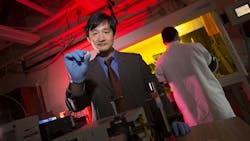UNL researchers double efficiency of perovskite photovoltaics with fullerenes
A group at the University of Nebraska--Lincoln has doubled the power-conversion efficiency of a certain type of perovskite solar cell by unraveling the origins of a phenomenon known to hinder the cell's performance, stability, and evaluation.1
The organometal trihalide perovskite (CH3NH3)PbI3 ordinarily exhibits photocurrent hysteresis (undesirable shifts in electrical conductivity that arise when applying increasing or decreasing amounts of voltage to a cell for the purpose of measuring its photocurrent); the group determined that this hysteresis results from the presence of “traps” that can ensnare electrons and reduce electric current. The traps also diminish the lifespan of perovskite-based devices and complicate measurements of how efficiently such devices convert sunlight into electricity.
“It makes measurements of efficiency much more difficult and much less accurate, says Jinsong Huang, the group's leader. "It can actually lead to false information about how efficient a device is. That matters a lot in the field of photovoltaics, because even a 1% increase is a big deal.”
Huang’s team further identified the sites of the traps, which reside both at perovskite’s surface and along the boundaries of the microscopic grains that form its foundation.
The researchers resolved the problem by fabricating and depositing a thin film of fullerenes onto the perovskite, which effectively filled a large number of the traps and made the solar cell two times more efficient.
Source: http://news.unl.edu/newsrooms/unltoday/article/engineers-id-address-cause-of-solar-cell-issue/
REFERENCE:
1. Yuchuan Shao et al., Nature Communications (2014); http://dx.doi.org/10.1038/ncomms6784

John Wallace | Senior Technical Editor (1998-2022)
John Wallace was with Laser Focus World for nearly 25 years, retiring in late June 2022. He obtained a bachelor's degree in mechanical engineering and physics at Rutgers University and a master's in optical engineering at the University of Rochester. Before becoming an editor, John worked as an engineer at RCA, Exxon, Eastman Kodak, and GCA Corporation.
